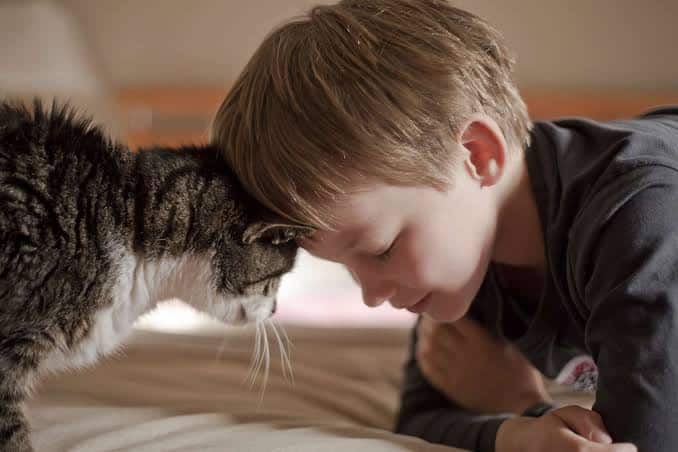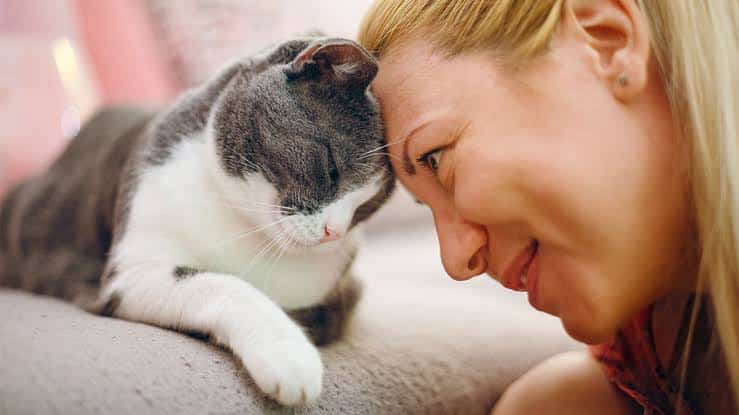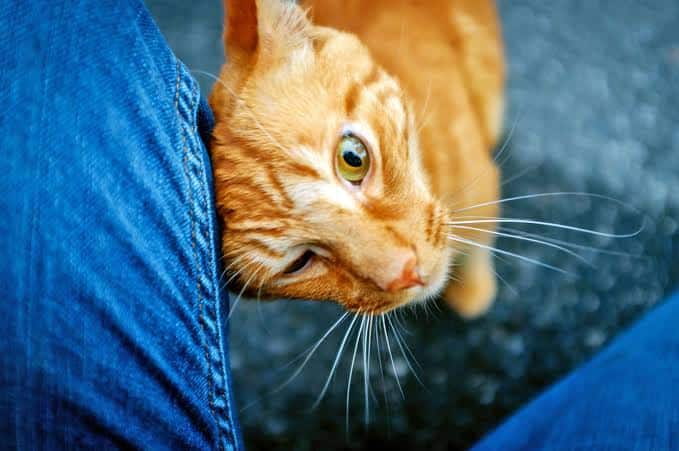Cats are known for their mysterious and sometimes perplexing behaviors, leaving their human companions wondering about the meaning behind each quirky gesture. One behavior stands out: the gentle yet deliberate act of headbutting. We shall reveal the answers to the question “Why Does My Cat Headbutt Me?”.
Understanding Cat Communication
Cats are known for their unique and subtle ways of communicating, using a combination of vocalizations, body language, and scent marking to convey their thoughts and feelings. Understanding cat communication is essential for building a strong bond with your feline companion and interpreting their needs and desires accurately.
Vocalizations
Common vocalizations include meowing, purring, hissing, growling, and chirping, each with its own meaning and purpose.
Meowing is primarily used by cats to communicate with humans, often to request attention, food, or affection.
Purring is a sign of contentment and relaxation in cats, although it can also indicate pain or distress in some cases.
Hissing and growling are defensive vocalizations used by cats to express fear, aggression, or discomfort.
Body Language
Cats rely heavily on body language to communicate with each other and with humans.
Tail position, ear position, facial expressions, and body posture all convey important information about a cat’s mood and intentions.
A relaxed and upright tail indicates a content and confident cat, while a tucked tail suggests fear or submission.
Ears held forward indicate curiosity or interest, while flattened ears signal aggression or fear.
Slow blinking is a sign of trust and affection in cats, often used as a form of communication between cats and their human companions.
Scent Marking
Scent marking is a common form of communication used by cats to establish territory, communicate with other cats, and express familiarity or affection towards humans.
Headbutting, rubbing against objects, and scratching are all ways that cats deposit their scent and communicate with their environment.
Cats may also engage in mutual grooming to reinforce social bonds and distribute scent among members of their social group.
Recommended: Are Snake Plants Toxic To Cats: See How Snake Plants Can Affect Cats

The Purpose Of Cat Headbutting
Cat headbutting, also known as “head bunting” or “head pressing,” is a behavior commonly observed in cats that serves multiple purposes in feline communication and social interaction. While it may seem strange to humans, headbutting is a natural behavior that cats use to express affection, establish social bonds, and communicate with their human companions and other cats.
Affection And Bonding
One of the primary purposes of cat headbutting is to express affection and strengthen bonds between cats and their human companions.
When a cat headbutts you, it’s a sign of trust and affection, as they are choosing to initiate physical contact and share their scent with you.
The act of headbutting releases endorphins in both the cat and the recipient, creating a sense of relaxation and contentment for both parties.
Scent Marking
Cats have scent glands located on their heads, specifically around the cheeks and forehead.
Headbutting allows cats to deposit their scent onto objects and individuals, marking them as familiar and safe territory.
By transferring their scent through headbutting, cats communicate ownership, establish boundaries, and create a sense of security in their environment.
Social Interaction
Headbutting is also a common form of social interaction among cats and between cats and other animals.
Cats may headbutt each other as a greeting or to reaffirm their social bonds within a group.
When a cat headbutts a human, they are extending the same social behaviors they would use with other cats, indicating that they see their human companion as part of their social group.
Comfort And Security
For some cats, headbutting serves as a comforting and soothing behavior, especially during times of stress or anxiety.
The physical contact and exchange of scent that occur during headbutting can provide reassurance and a sense of security for cats, helping them feel more at ease in their surroundings.
Overall, cat headbutting is a multifaceted behavior that serves as a means of expressing affection, marking territory, facilitating social interaction, and providing comfort and security.
How Headbutting Signifies Affection And Trust Between Cats And Humans
Headbutting is a natural and instinctual behavior for cats, rooted in their social and communicative repertoire.
Expressing Affection:
When a cat headbutts you, it’s their way of expressing fondness and affection towards you.
The gentle act of pressing their head against you is a sign of trust and comfort, as they are choosing to initiate physical contact and share their scent with you.
Cats may accompany headbutting with purring, kneading, or rubbing against you, further indicating their affectionate feelings towards you.
Strengthening Bonds:
Headbutting serves to strengthen the bond between cats and their human companions.
By engaging in headbutting, cats are establishing a positive association with you and reinforcing the emotional connection they feel towards you.
The act of sharing scent through headbutting helps cats recognize you as a familiar and trusted member of their social group, fostering a sense of security and belonging.
Building Trust:
Headbutting also plays a role in building trust between cats and humans.
When a cat headbutts you, they are demonstrating their trust in you and their willingness to engage in physical contact and close proximity.
Consistently responding positively to your cat’s headbutts, such as by offering gentle petting or verbal praise, reinforces the bond of trust between you and your feline companion.
Recommended: Can Cats Eat Coconut?

How Headbutting Allows Cats To Transfer Their Scent Onto Humans
Headbutting is not only a gesture of affection and trust from cats to humans but also serves as a means for cats to transfer their scent onto their human companions. This scent transfer is a crucial aspect of feline communication and plays a significant role in strengthening the bond between cats and their human counterparts.
Scent Glands:
Cats have scent glands located on various parts of their bodies, including the head, cheeks, and chin.
These scent glands secrete pheromones, chemical substances that convey information about a cat’s identity, territory, and emotional state.
The scent glands on a cat’s head, specifically around the cheeks and forehead, are particularly active during headbutting.
Marking Territory:
Scent marking is an essential form of communication for cats, allowing them to establish territory, communicate with other cats, and express familiarity and security.
When a cat headbutts a human, they are transferring their scent onto the person, marking them as familiar and safe territory.
This scent marking behavior helps cats feel more comfortable and secure in their environment, as they recognize the presence of their own scent.
Social Bonding:
Headbutting allows cats to share their scent with their human companions, fostering a sense of social connection and bonding.
By transferring their scent onto humans, cats are integrating them into their social group and signaling their acceptance and trust.
This mutual scent exchange helps strengthen the emotional bond between cats and humans, promoting a deeper sense of companionship and understanding.
Recognition and Familiarity:
Cats rely on scent cues to recognize familiar individuals and establish social relationships.
When a cat headbutts a human and transfers their scent onto them, they are essentially marking the person as part of their social circle.
This scent exchange helps cats feel more comfortable and relaxed in the presence of their human companions, as they perceive them as familiar and trustworthy.
Recommended: British Shorthair Cat Breed

Individual Variations And Context Of Cat Headbutting
Each cat is unique, and the reasons behind their headbutting may vary based on their personality, past experiences, and the specific circumstances in which the behavior occurs.
Personality Differences:
Some cats may be more affectionate and prone to headbutting as a means of expressing their fondness towards their human companions.
Other cats may be more reserved or independent, preferring other forms of communication or interaction.
Past Experiences:
A cat’s past experiences and socialization history can shape their behavior and attitudes towards humans and other animals.
Cats who have positive associations with humans from a young age may be more likely to engage in headbutting as a form of social bonding and affection.
Cats who have had negative experiences or lack socialization may be more hesitant to engage in headbutting or other forms of physical contact.
Environmental Factors:
The environment in which a cat lives can also influence their headbutting behavior.
Cats who feel safe and secure in their surroundings are more likely to engage in headbutting as a means of marking territory and expressing trust.
Changes in the environment, such as moving to a new home or the introduction of new pets, may impact a cat’s headbutting behavior and overall comfort level.
Human Response:
How humans respond to a cat’s headbutting can also affect the frequency and context in which the behavior occurs.
Positive reinforcement, such as gentle petting and verbal praise, can encourage a cat to continue engaging in headbutting as a means of seeking attention and affection.
Conversely, negative reactions or lack of response may discourage a cat from engaging in headbutting or other forms of physical contact.
Social Context:
Headbutting behavior may also vary depending on the social context in which it occurs.
Cats may headbutt their human companions as a greeting, a request for attention, or a form of reassurance during times of stress or anxiety.
Understanding the specific circumstances in which a cat headbutts can provide valuable insights into their emotional state and social needs.
Recommended: Melatonin for Cats
Conclusion
Cat headbutting is a fascinating behavior that serves multiple purposes in feline communication and social interaction. While it may seem peculiar to humans, headbutting is a natural and instinctual behavior for cats, rooted in their social and communicative repertoire.
Throughout this article, we’ve explored the various reasons why cats headbutt their human companions, including as a gesture of affection and trust, a means of transferring scent, and a form of social bonding. We’ve also discussed the individual variations and context that can influence cat headbutting behavior, highlighting the importance of understanding each cat’s unique personality, experiences, and environment.
By recognizing the significance of cat headbutting and responding positively to this behavior, cat owners can deepen their bond with their feline companions.
